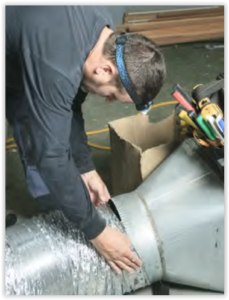An Airborne Problem
TESTING FOR AND PREVENTING RESPIRABLE CRYSTALLINE SILICA
 There are all sorts of particles that present health risks to workers when inhaled. The Occupational Safety and Health Administration (OSHA) is constantly on the lookout for ways to limit disease through monitoring and regulating the levels of contaminants in the air. One particular particle that poses all sorts of health risks is respirable crystalline silica, and it is important to know how you can keep it from hurting building occupants.
There are all sorts of particles that present health risks to workers when inhaled. The Occupational Safety and Health Administration (OSHA) is constantly on the lookout for ways to limit disease through monitoring and regulating the levels of contaminants in the air. One particular particle that poses all sorts of health risks is respirable crystalline silica, and it is important to know how you can keep it from hurting building occupants.
Respirable crystalline silica can build up very rapidly during construction and remodeling projects. It is a common element in prominent building materials like sand, granite, and quartz, and it becomes respirable when it is small enough to travel to the deep lung tissue (alveoli) through the air, which often happens when cutting the aforementioned materials. Without proper education, construction projects may see a spike in unsafe silica concentration levels.
People engaged in stone cutting and similar professions are at an extremely high risk for silicate exposure. If buildings are not tested for silica levels, the risks spread to all occupants to the building, making a space unfit for habitation. Respirable crystalline silica is a classified lung carcinogen and carries the risk of silicosis and tuberculosis. With these diseases, compliance with OSHA regulations is crucial to creating a safe working and living environment.
There are many ways that employers and building managers can protect people from the risks of respirable crystalline silica. The first is to make sure that you undergo consistent and accurate testing. If you don’t know you have an issue with particle levels, you cannot take the steps to eliminate them. It is especially important to test particle levels before and after construction projects. Any time the particle level can be altered, testing should be done as a matter of course. You can also limit silica exposure by replacing silica-containing materials with safer alternatives whenever possible.
While it can be easy to regard dust as simply a nuisance, the truth is that it can be much more harmful than that. Especially when sandblasting or stone cutting, dust accumulation can be a sign of particulate build up. Staying proactive on testing levels and engaging in safe construction practices will go a way long in maintaining safe levels respirable crystalline silica at your property.
